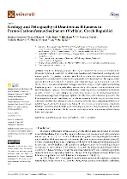Geology and Petrography of Uraniferous Bitumens in Permo-Carboniferous Sediments (Vrchlabí, Czech Republic)

Autor
Havelcová, Martina
Sýkorová, Ivana
Datum vydání
2022Publikováno v
MineralsRočník / Číslo vydání
12 (5)ISBN / ISSN
ISSN: 2075-163XMetadata
Zobrazit celý záznamKolekce
Tato publikace má vydavatelskou verzi s DOI 10.3390/min12050544
Abstrakt
Uraniferous bitumens found in black shales from the Permian rocks at Vrchlabí in the Krkonoše Piedmont Basin (Czech Republic) were described and characterized petrologically and mineralogically. The Permian sediments originated from weathering products in metasediments and granitoids of the Krkonoše-Jizera and Orlice-Snežník crystalline complexes. The organic matter contained up to 4.8 wt.% uranium, as uraninite grains. Elements associated with uraninite, such as Pb, Zr, Cu, and As, may have accumulated from epigenetic fluids in layers rich in organic matter during their late diagenesis. The bitumen structures were extremely heterogeneous, a feature attributed to the radiolytic effects of uranium. Amorphous bitumens, alternating with various forms of nodular and corroded bitumen types from multiple generations, were present. Low and highly altered bitumens with weak anisotropy were recognized, together with halo zones, with reflectance up to 4.37%. The halo zones differed in size, brightness, and reflectance, increasing from the edge to the center. Halos often revealed dark rims between uraninite inclusions and clear zones, originating probably as a result of weaker alterations in organic matter due to the presence of other inorganic components. Uranium concentration was the main factor controlling the degree of radiolytic alteration. The studied uraniferous bitumens are an excellent example of multistage formation and diverse evolution during burial and diagenesis.
Klíčová slova
uraninite, bitumen, halos, bireflectance, radiolytic alteration
Trvalý odkaz
https://hdl.handle.net/20.500.14178/1936Licence
Licence pro užití plného textu výsledku: Creative Commons Uveďte původ 4.0 International






